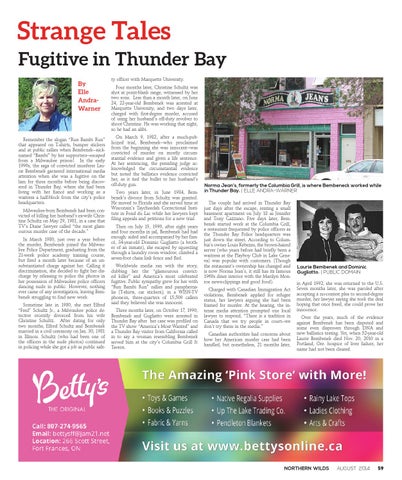Strange Tales Fugitive in Thunder Bay By Elle AndraWarner
Remember the slogan “Run Bambi Run” that appeared on T-shirts, bumper stickers and at public rallies when Bembenek—nicknamed “Bambi” by her supporters—escaped from a Milwaukee prison? In the early 1990s, the saga of convicted murderer Laurie Bembenek garnered international media attention when she was a fugitive on the lam for three months before being discovered in Thunder Bay, where she had been living with her fiancé and working as a waitress a half-block from the city’s police headquarters. Milwaukee-born Bembenek had been convicted of killing her husband’s ex-wife Christine Schultz on May 29, 1981, in a case that TV’s Diane Sawyer called “the most glamourous murder case of the decade.” In March 1980, just over a year before the murder, Bembenek joined the Milwaukee Police Department, graduating from the 21-week police academy training course, but fired a month later because of an unsubstantiated charge against her. Calling it discrimination, she decided to fight her discharge by releasing to police the photos in her possession of Milwaukee police officers dancing nude in public. However, nothing ever came of any investigation, leaving Bembenek struggling to find new work. Sometime late in 1980, she met Elfred “Fred” Schultz Jr., a Milwaukee police detective recently divorced from his wife Christine Schultz. After dating for only two months, Elfred Schultz and Bembenek married in a civil ceremony on Jan. 30, 1981 in Illinois. Schultz (who had been one of the officers in the nude photos) continued in policing while she got a job as public safe-
ty officer with Marquette University. Four months later, Christine Schultz was shot at point-blank range, witnessed by her two sons. Less than a month later, on June 24, 22-year-old Bembenek was arrested at Marquette University, and two days later, charged with first-degree murder, accused of using her husband’s off-duty revolver to shoot Christine. He was working that night, so he had an alibi. On March 9, 1982, after a much-publicized trial, Bembenek—who proclaimed from the beginning she was innocent—was convicted of murder on mostly circumstantial evidence and given a life sentence. At her sentencing, the presiding judge acknowledged the circumstantial evidence but noted the ballistics evidence convicted her, as it tied the bullet to her husband’s off-duty gun. Two years later, in June 1984, Bembenek’s divorce from Schultz was granted. He moved to Florida and she served time at Wisconsin’s Taycheedah Correctional Institute in Fond du Lac while her lawyers kept filing appeals and petitions for a new trial. Then on July 15, 1990, after eight years and four months in jail, Bembenek had had enough: aided and accompanied by her fiancé, 34-year-old Dominic Gugliatto (a brother of an inmate), she escaped by squeezing through a laundry room window, climbed a seven-foot chain link fence and fled. Worldwide media ran with the story, dubbing her the “glamourous convicted killer” and America’s most celebrated fugitive. Public sympathy grew for her with “Run Bambi Run” rallies and paraphernalia (T-shirts, car stickers); in a WISN-TV phone-in, three-quarters of 15,500 callers said they believed she was innocent. Three months later, on October 17, 1990, Bembenek and Gugliatto were arrested in Thunder Bay after her case was profiled on the TV show “America’s Most Wanted” and a Thunder Bay visitor from California called in to say a woman resembling Bembenek served him at the city’s Columbia Grill & Tavern.
Norma Jean’s, formerly the Columbia Grill, is where Bembeneck worked while in Thunder Bay. | ELLE ANDRA-WARNER The couple had arrived in Thunder Bay just days after the escape, renting a small basement apartment on July 18 as Jennifer and Tony Gazzano. Five days later, Bembenek started work at the Columbia Grill, a restaurant frequented by police officers as the Thunder Bay Police headquarters was just down the street. According to Columbia’s owner Louis Kebezes, the brown-haired server (who years before had briefly been a waitress at the Playboy Club in Lake Geneva) was popular with customers. (Though the restaurant’s ownership has changed and is now Norma Jean’s, it still has its famous 1960s diner interior with the Marilyn Monroe news-clippings and good food). Charged with Canadian Immigration Act violations, Bembenek applied for refugee status, her lawyers arguing she had been framed for murder. At the hearing, the intense media attention prompted one local lawyer to respond, “There is a tradition in Canada that we try people in court—we don’t try them in the media.” Canadian authorities had concerns about how her American murder case had been handled, but nonetheless, 21 months later,
Laurie Bembenek and Dominic Gugliatto. | PUBLIC DOMAIN in April 1992, she was returned to the U.S. Seven months later, she was paroled after accepting a no-contest plea to second-degree murder, her lawyer saying she took the deal hoping that once freed, she could prove her innocence. Over the years, much of the evidence against Bembenek has been disputed and some even disproven through DNA and new ballistics testing. Yet, when 52-year-old Laurie Bembenek died Nov. 20, 2010 in a Portland, Ore. hospice of liver failure, her name had not been cleared.
NORTHERN WILDS
AUGUST 2014
59
